
Australian researchers are the most productive of all the G20 nations.
Credit: Michael Hall/Getty Images
10 key insights from the first research scorecards for G20 countries
Australia shines; the US, not so much.
19 July 2019

Michael Hall/Getty Images
Australian researchers are the most productive of all the G20 nations.
New scorecards produced by Clarivate to coincide with the recent G20 summit in Osaka, Japan, reveal the impact of the research carried out by some of the world’s most prosperous economies.
The analysis compares research performance based on metrics including publications, citations, international collaboration, funding, researcher output and diversity.
The G20 countries were responsible for 70% of global research papers tracked by Web of Science over the past three years. They represent two-thirds of the world's population and employ 87% of researchers globally.
Nine of these nations also appear in the Nature Index Top 10 Countries/Territories table, which measures output in high-quality journals.
Australia, which knocked Spain out of tenth place this year in the Nature Index, is punching well above its weight, as highlighted by the G20 scorecards.
Below is a breakdown of the 10 most interesting insights from the report.
You can read the full report here.
1. Australian researchers are powerhouses of productivity
Australian research output has doubled over the past decade – a steep increase that is the most pronounced of all the G20 members, though it is now plateauing. Its researchers are producing a remarkable number of papers between them, well above the G20 average.
As Times Higher Education reports, the country puts each US$1 million of funds into about 3.5 research papers, which is well above the United States' efficiency rating of less than 1 research paper per million.
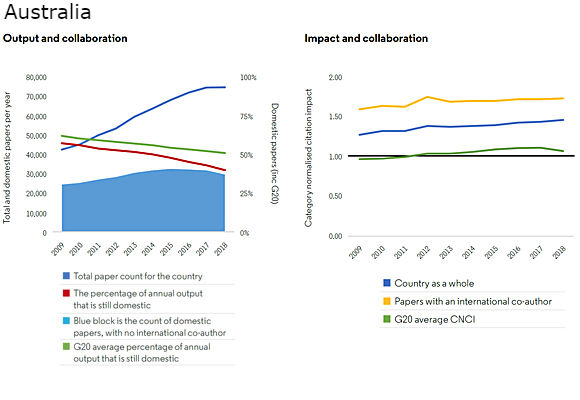
These graphs show impact and output trends over the past 10 years. The grey line in the impact and collaboration graph ("1.00"), represents the world average. Credit: Clarivate
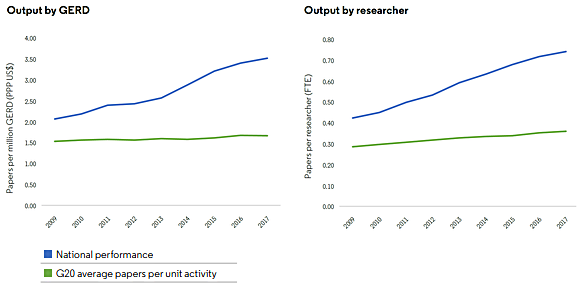
Research productivity is analyzed in terms of both output per unit GERD funding and output by researcher. Credit: Clarivate
2. Argentina has the highest proportion of female scientists
At 53%, Argentina boasts the highest percentage of female scientists of the G20 nations (although about half of them are data deficient in this area).
Japan, with 16.2% female researchers, has the lowest proportion, and by a large margin – the average among the G20 countries is 34% (with the caveat that many countries, including the US and Canada, are data deficient and hence not counted).

3. Japan's researchers are struggling to produce
In stark contrast to Australia, output per researcher in Japan is well below the G20 average, as is the country's value for money.
While increasing global connections is a priority for the country, around 30% of papers analyzed in the report have international co-authors, compared with Germany’s 54.4%.

Research productivity is analyzed in terms of both output per unit GERD funding and output by researcher. Credit: Clarivate
4. The UK rules on papers
The United Kingdom's share of papers in the global top 10% of citations is the highest in the G20. At 14.5%, this share is double that of Japan’s share, at 7.1%.
Australia is hot on its heels, with 14% of its papers in the global top 10%.

5. US output and impact are in decline
While R&D expenditure in the US remains high, research impact and collaboration are in decline, both domestic and international. Researcher output has fallen below the G20 average, and citation impact lags behind the UK.
Even so, the US looms large in producing high-quality research, and remains the dominant force in the Nature Index.
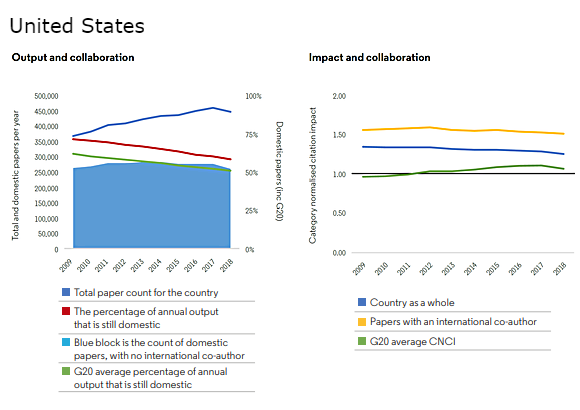
These graphs show impact and output trends over the past 10 years. The grey line in the impact and collaboration graph ("1.00"), represents the world average. Credit: Clarivate
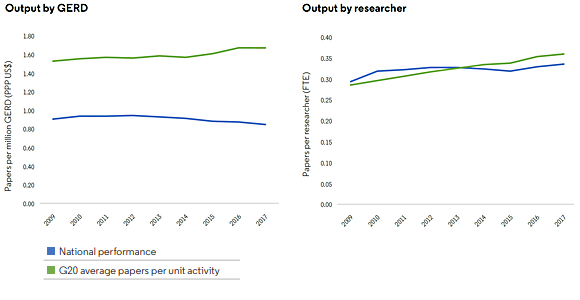
Research productivity is analyzed in terms of both output per unit GERD funding and output by researcher. Credit: Clarivate
6. Indonesia is one to watch
Research output for Indonesia might be small compared to many of the G20 countries, but it’s increased threefold in a decade, across all disciplines. Its international connections are a strength – more than 75% of this output is internationally collaborative.
Regarding its domestic papers, more than 40% of them are uncited, which is the highest in the G20. South Korean domestic papers, by example, have an uncited rate of just over 20%, and Mexico’s domestic uncited rate is around 28%.

7. China's research output is sky-rocketing
The graph below says it all. Over the past decade, China's research output has advanced by leaps and bounds.
But, unlike Australia, whose efficiency stands out among the group, China's output compared to its research spending is below average for the G20 group.
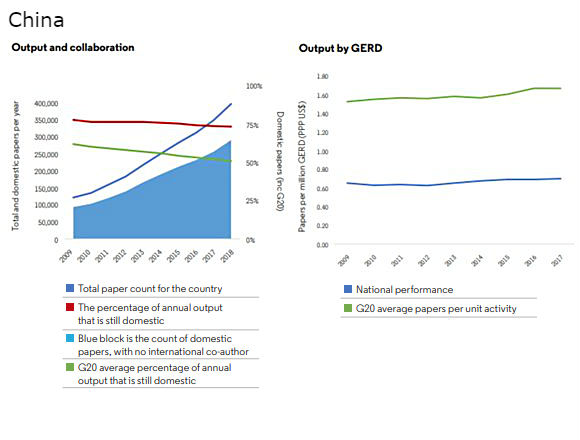
The graph on the left shows graphs shows output and collaboration trends over the past 10 years The graph on the right shows research productivity analyzed in terms of output per unit GERD. Credit: Clarivate
8. Japan wins on patents
It might be underperforming in terms of productivity, but Japan is not lacking in novel ideas. When comparing the number of patents per business enterprise R&D spending (BERD), Japan counts 3,420.9 over the past year – the highest of all the G20 nations.
Other big players in patenting include China at 3,393.8 patents and South Korea at 3,136.2. Research giants like the US and Germany trail at 1,321.8 and 1,936.2, respectively.

9. South Korea is spending a lot of money on research
The GERD/GDP looks at gross domestic expenditure on R&D (GERD) as a percentage of GDP. At 4.55%, South Korea’s GERD/GDP is exceptionally high.
For comparison, it’s followed by Japan at 3.20% and Germany at 3.02%. The US and China are at 2.79% and 2.12% GERD/GDP, respectively.
The report notes that South Korea’s high expenditure has so far not been translated into output, where productivity is well below G20 averages.
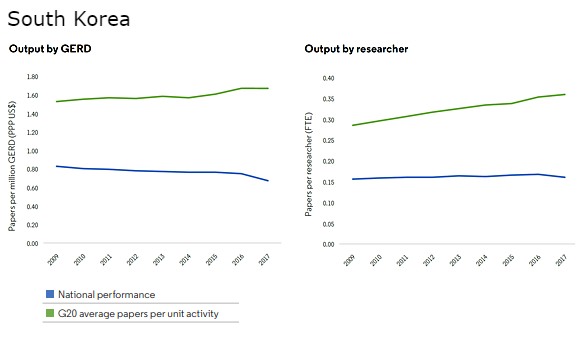
Research productivity is analyzed in terms of both output per unit GERD funding and output by researcher. Credit: Clarivate
10. Open access publishing is on the rise
While big players such as Germany and the US are below the G20 average for open access publishing, they are showing an increase in output.
Meanwhile, countries like Mexico, Saudi Arabia, South Africa and South Korea have embraced it across all disciplines.

The trends and patterns in open access research publication are shown in a graph and research footprint. On the right, Med = medicine, Life = life sciences, MPS = maths and physical sciences, Eng = engineering and technology, Soc = social sciences, A&H = arts and humanities, A&D = art and design, H&L = humanities and languages, SAM = subjects allied to medicine. Credit: Clarivate
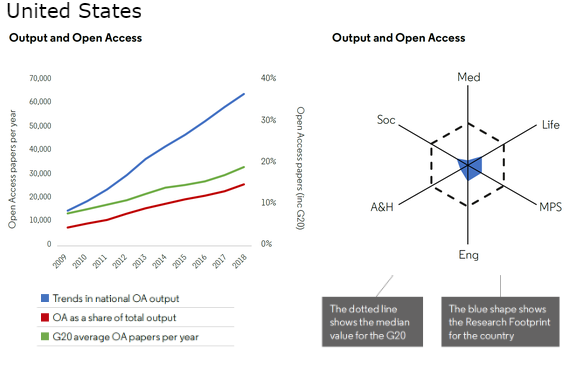
The trends and patterns in open access research publication are shown in a graph and research footprint. Credit: Clarivate
Read the full report here.
If you enjoyed this story, please consider subscribing to our newsletter.
Read next:
The top 10 countries for scientific research in 2018
Dataviz: The top 10 countries in research collaboration
The top 10 countries that dominate natural sciences research
